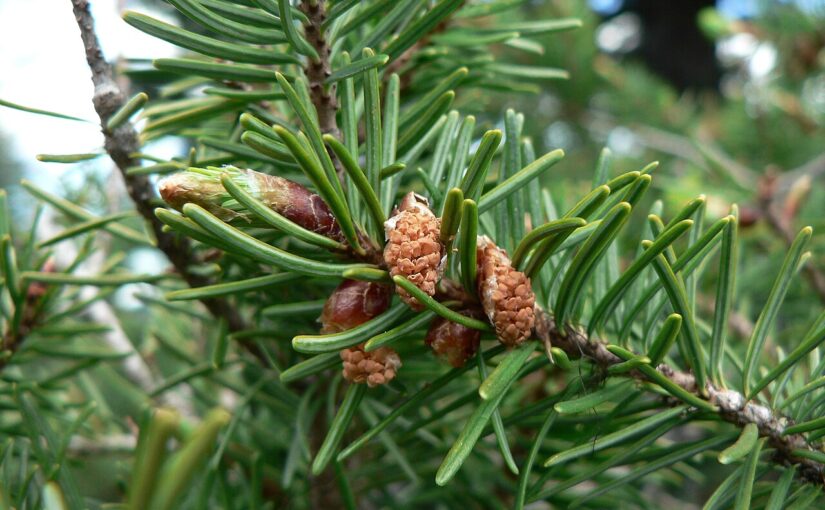Douglas fir essential oil is derived from Pseudotsuga menziesii, also known as Douglas spruce or Oregon pine. This majestic conifer is native to western North America, thriving in the lush landscapes of the Pacific Northwest from British Columbia down to California. The essential oil is produced by steam-distilling the young needles and branches, with the United States and Canada leading its production. Douglas fir oil is clear and thin in consistency and has a distinctive aroma that is fresh, green, and airy, with lively pine notes and a bright, lemony-citrus undertone. The principle compounds found in the oil include alpha-pinene, beta-pinene, limonene, myrcene, sabinene, carene, terpinene, and terpinolene, which contribute to its vibrant scent and wide-ranging effects.
Historical and Cultural Significance
Named for Scottish botanist David Douglas, who introduced the tree to Europe in the nineteenth century, the Douglas fir has become a symbol of resilience and longevity. It is a North American icon, often selected as a Christmas tree for its beautiful aroma and lush needles. Though not a true fir, and technically classified as a false hemlock, Douglas fir can grow to immense heights, sometimes reaching three hundred feet, and some individuals live for centuries, embodying strength and endurance. The tree’s citrusy scent has captivated native cultures and settlers alike, inviting feelings of winter cheer, forest clarity, and deep-rooted vitality. Its use today in aromatherapy continues a tradition of appreciating its uplifting energy and cleansing powers.
Therapeutic Benefits
Douglas fir essential oil offers a spectrum of therapeutic benefits, many centered on respiratory health and immunity. As a decongestant and expectorant, it helps to clear bronchial and nasal passages, making it a natural ally for those suffering from coughs, asthma, bronchitis, colds, and flu. Its antibacterial and antimicrobial properties enable it to purify air and support the healing of wounds, protecting the body from infection and promoting faster recovery.
For joint pain, muscle sprains, rheumatism, and post-workout soreness, Douglas fir oil’s anti-inflammatory and antispasmodic qualities bring relief, reducing swelling and calming tired muscles. It is also an antioxidant and immunostimulant, boosting the body’s defenses and protecting against oxidative stress. The antiviral action of Douglas fir promotes healing during viral illnesses, helping the body recover from colds and flu. Used as a deodorant, it neutralizes odors, adding a clean, forest-fresh ambience to the home. As an antiseptic, it effectively cleans surfaces and skin, further preventing infections. The oil’s high pinene content is responsible for much of its respiratory, anti-inflammatory, and antimicrobial potency, solidifying its reputation as a prime choice for lung health and pain relief.
Aromatherapy Uses
Douglas fir essential oil brings the crisp breath of mountain forests into the home and wellness routines. In diffusion, a blend of three drops Douglas fir and three drops tangerine in water offers an uplifting mood boost and cleanses indoor air, combating winter blues and seasonal melancholy. Steam inhalation with three drops in a bowl of heated water creates a cleansing vapor, which can be inhaled to clear congestion and support respiratory wellness.
For topical applications, the oil must be diluted for safety. Ten to twenty drops in one ounce of carrier oil such as jojoba provide an effective massage blend, soothing joint pain, muscle aches, and rheumatism. A relaxing bath can be prepared with six to eight drops combined with a dispersant, melting tension and breathing difficulties away.
In household routines, Douglas fir oil is valued in natural cleaning sprays for its antiseptic properties and fresh scent. Its potent aroma means it should be used sparingly in diffusers and always appropriately diluted for topical use.
Emotional and Energetic Effects
The aroma of Douglas fir essential oil is more than pleasant: it is emotionally and energetically transformative. The fresh, piney scent uplifts and rejuvenates, banishing feelings of anxiety, nervousness, and seasonal sadness. Users often notice a more positive, present outlook, grounded in the serenity of forest energy. The oil is associated with the heart and throat chakras and the yang energy of the wood element, inspiring clarity, vitality, and emotional equilibrium. For those seeking to overcome emotional stagnation or looking to enhance meditation, Douglas fir offers the same invigorating sense of walking through a crisp Oregon woodland: clear, grounded, and full of life.
Blending and Companion Oils
Douglas fir blends harmoniously with bergamot, eucalyptus, frankincense, lavender, lemon, lemongrass, sandalwood, sweet orange, tangerine, vetiver, and other woodsy oils. These combinations result in aromas that are both uplifting and relaxing, suited to a range of moods and wellness goals. For similar effects on respiratory and emotional wellbeing, pine, spruce, or cedarwood provide excellent substitutes, though they lack Douglas fir’s signature citrus brightness.
Safety and Precautions
Safe use is critical when engaging with Douglas fir essential oil. Pregnant women should avoid the oil given limited safety data, and consultation with a healthcare provider is recommended for use with children. Skin sensitization can occur in sensitive individuals, so always dilute the oil to one or two percent, or six to twelve drops per ounce of carrier oil, and perform a patch test before full use. The oil should be stored in a tightly capped, dark glass bottle in a cool, dark environment to preserve its qualities for three to five years. External use only is advised unless under the supervision of a professional.
Douglas Fir’s Forest Glow
The crisp, lemony-pine breeze of a Pacific Northwest forest fills each drop of Douglas fir essential oil. Its vibrant aroma draws from the resilience and majesty of trees that endure for centuries. Whether clearing airways, easing aches, or lifting the spirit, Douglas fir serves as a versatile ally in holistic wellness. It draws in deep breaths and brighter moods, carrying the forest glow into daily life while echoing the enduring legacy of Oregon pine.
Image by Walter Siegmund.
